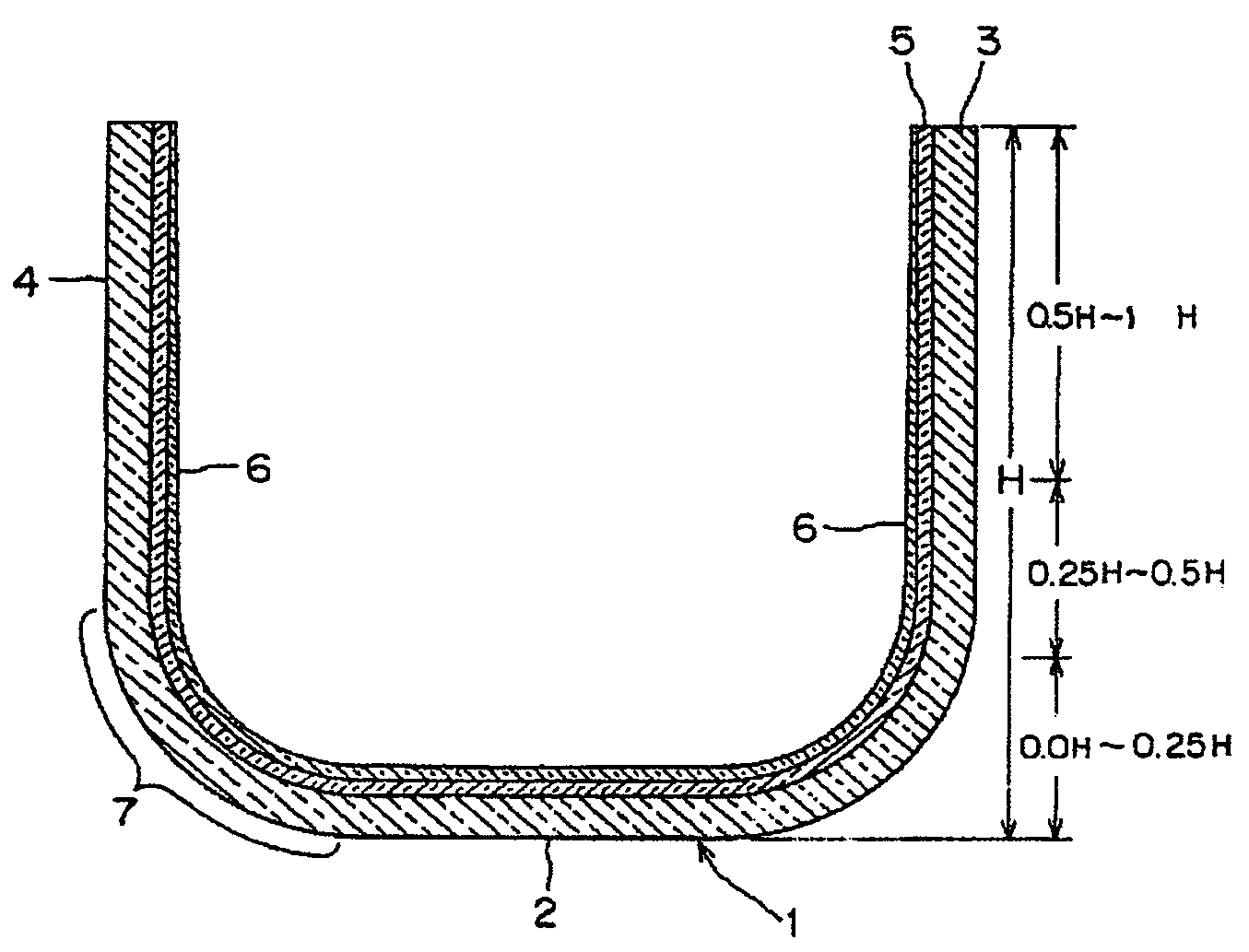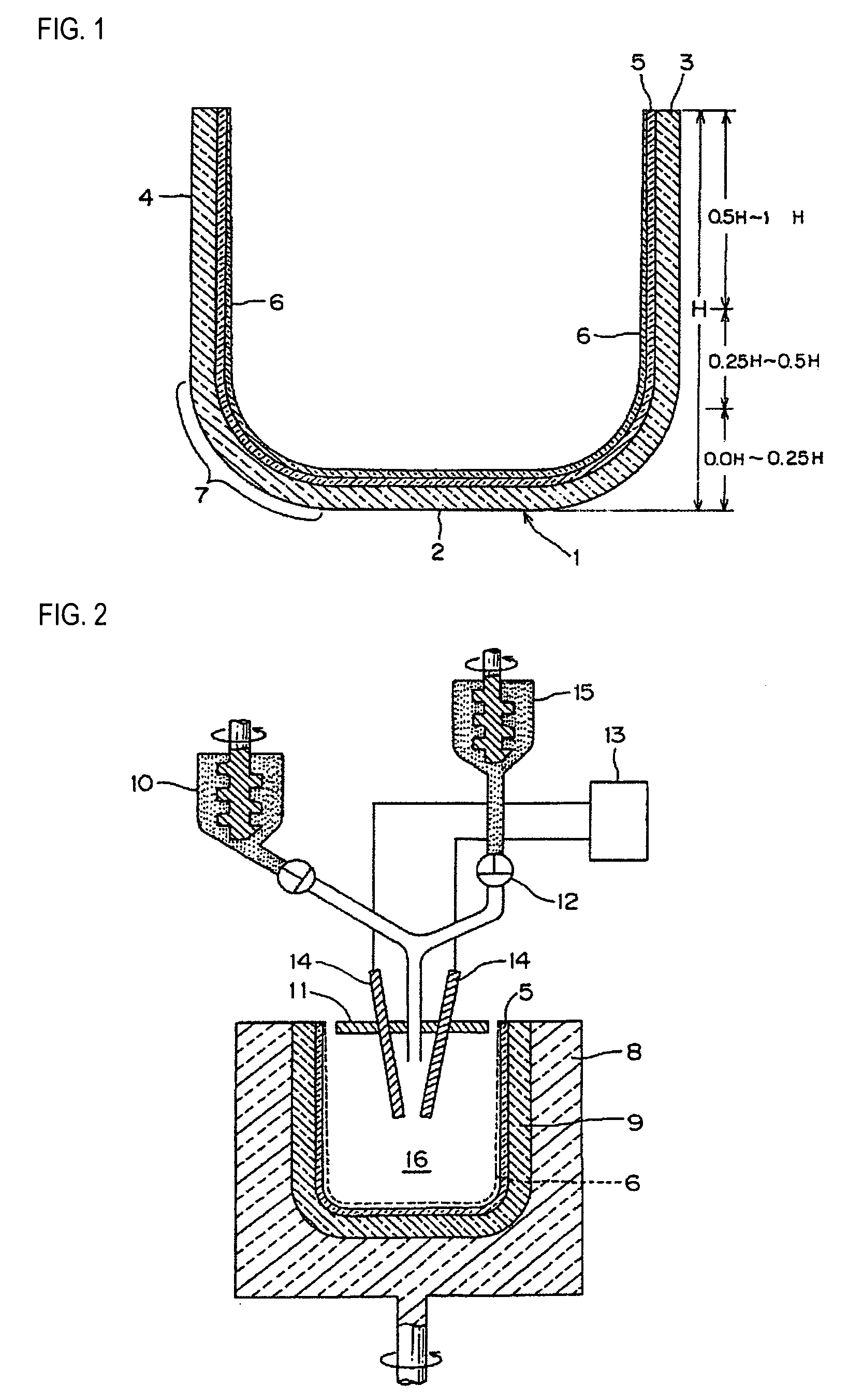Quartz glass crucible for the pulling up of silicon single crystal
a glass crucible and silicon single crystal technology, applied in glass making apparatus, crystal growth process, manufacturing tools, etc., can solve the problems of reducing the yield of silicon single crystal, increasing the manufacturing cost caused by the increase in complexity of operations, and undesirable effects of lowering product yield
- Summary
- Abstract
- Description
- Claims
- Application Information
AI Technical Summary
Benefits of technology
Problems solved by technology
Method used
Image
Examples
working example 1
[0016]Employing the device shown in FIG. 2, a refined high-purity natural silica powder was introduced into the rotating mold 8 and, by the centrifugal forces thereof, was moulded into the shape of the quartz glass crucible, the arc electrode 14 was then inserted therein, the opening part was covered with the disk-shaped cover 11, and a high-temperature gas atmosphere was created in the inner cavity by the arc electrode 14 resulting in the formation of a molten glass which was then cooled to produce the non-transparent quartz glass crucible-shaped molded body 9. Next, with the mold 8 rotating, a high-temperature atmosphere 16 was created in the inner cavity of the transparent quartz glass crucible-shaped molded body 9 by the arc electrode 14, natural silica powder was then supplied from the silica powder supply means 10 at 100 g / min, and the natural quartz glass transparent intermediate layer 5 of thickness 2 mm was integrally-fused with the inner surface of the non-transparent quar...
working example 2
[0017]Apart from the alteration of the TA1, TA2, TA3 of working example 1 to 1.5 mm, a 24-inch quartz glass crucible for the pulling up of silicon single crystals identical to that of working example 1 was produced. The CA of said crucible was 0.02 ppm, the CB was 6 ppm, and the CC was 14 ppm. Although, in the actual use of this quartz glass crucible, the average single crystal conversion rate following the packing and melting of polycrystalline silicon and the pulling up of a single crystal based on the CZ method 5 times was a high yield of 95%, the oxygen concentration toward the upper side of the single crystal was high and was only just within the advised standard.
working example 3
[0019]Employing the device shown in FIG. 2, a refined high-purity natural silica powder was introduced into the rotating mold 8 and, by the centrifugal forces thereof, was molded into the quartz glass crucible molded shape, a natural silica powder was further introduced into the mold and, by the centrifugal forces thereof, was molded into an approximately 3 mm natural-synthetic blend silica layer, the arc electrode 14 was then inserted therein, the opening part was covered with the disk-shaped cover 11, and a high-temperature gas atmosphere was created in the inner cavity by the arc electrode 14 resulting in the formation of a molten glass which was then cooled to form the non-transparent quartz glass crucible-shaped molded body 9 configured from an approximately 2 mm natural-synthetic blend quartz glass layer and a natural quartz glass layer on the outer side thereof. Next, with the mold 8 rotating, the inner cavity of the non-transparent quartz glass crucible-shaped molded body 9 ...
PUM
| Property | Measurement | Unit |
|---|---|---|
| thickness TA3 | aaaaa | aaaaa |
| thickness TA3 | aaaaa | aaaaa |
| thickness TA3 | aaaaa | aaaaa |
Abstract
Description
Claims
Application Information
 Login to View More
Login to View More - R&D
- Intellectual Property
- Life Sciences
- Materials
- Tech Scout
- Unparalleled Data Quality
- Higher Quality Content
- 60% Fewer Hallucinations
Browse by: Latest US Patents, China's latest patents, Technical Efficacy Thesaurus, Application Domain, Technology Topic, Popular Technical Reports.
© 2025 PatSnap. All rights reserved.Legal|Privacy policy|Modern Slavery Act Transparency Statement|Sitemap|About US| Contact US: help@patsnap.com


